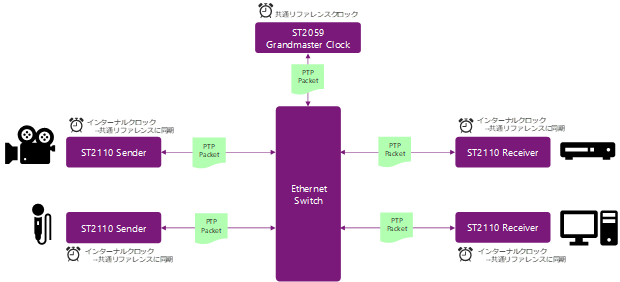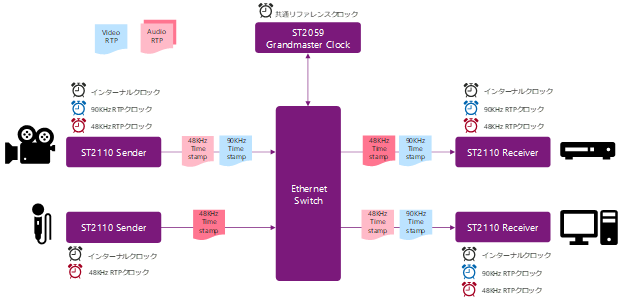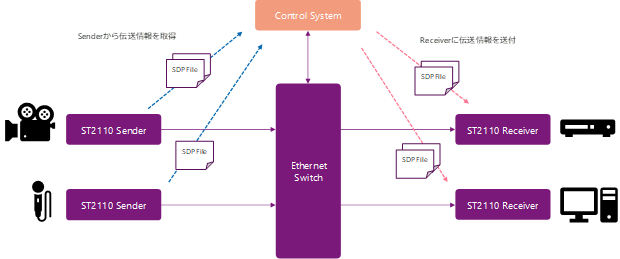1.First of all
SMPTE ST 2110 Professional Media Over Managed IP Networks (hereinafter referred to as SMPTE 2110 or ST2110) is an SMPTE standard that is an evolving set of standards for communicating professional video such as broadcasting over IP networks. With the standardization of this standard, the industry is transitioning from SDI-based to IP-based transmission. Macnica develops and provides FPGA / Software solutions such as the "SMPTE ST2110 FPGA IP Core" that allow customers to easily implement this standard.
This time, we will provide an overview of the SMPTE ST2110-10 standard.
2. 2. About SMPTE ST2110-10
ST2110-10 stipulates the following three basic requirements for establishing an entire transmission system using ST2110.
- Network interface requirements
- system timing model
- SDP (Session Description Protocol)
From the next section, I would like to see what is stipulated for each content.
3. Network interface requirements
In a nutshell, ST2110 indicates a standard for communicating each media essence such as video, audio, and ancillary data over Ethernet, but it is necessary to clarify what rules are used for transmission according to Ethernet in a nutshell. ST2110-10 performs data communication between ST2110 devices according to the following basic rules.
- All ST2110 transceiver devices support IPv4. Support for IPv6 is also expected in the future.
- Each media data is transmitted using UDP-based Real-Time Transport Protocol (RTP).
- The maximum UDP size is 1460 bytes. Support for Jumbo Frames with an upper limit of 8960 bytes is optional.
- Support both IPv4 Unicast and IPv4 Multicast.
Especially for IPv4 Multicast, it is necessary to understand and support related standards such as Internet Group Management Protocol, which may be the first hurdle in building a stable ST2110 transmission environment, so it is necessary to keep it firmly in mind. there is.
4. System Timing Model
Synchronization between the sender and receiver is important when transmitting video and audio data and playing them back in real time. If video and audio are transmitted and played in an asynchronous state, data buffer overflow or underflow will occur on the receiving side, making stable playback impossible.
In order to achieve synchronization between devices, conventional SDI-based systems have used BB (Black Burst) signals. The ST2110 system uses the PTP time synchronization mechanism instead of the BB signal. Time synchronization is the idea of synchronizing the internal clocks of all devices uniformly with a common reference clock, by preparing a clock (an internal clock) managed by each device. The ST2110 establishes this time synchronization using the IEEE 1588-2008 Precision Time Protocol and its extension for broadcast applications, SMPTE ST2059.
In a transmission system conforming to ST2110-10, a PTP grandmaster clock device compatible with ST2059 is normally arranged and used as a common reference clock. Each device in the system synchronizes the PTP Grandmaster Clock with its own internal clock through the exchange of PTP packets. This establishes time synchronization between all devices in the system. In ST2110-10, it is expected that the frequencies of the video data and audio data that are actually transmitted are synchronized with the internal clock, that is, the common reference clock. In other words, the basic concept of ST2110-10 is to build a system in which the entire system, including input and output media data, is synchronized.

The mechanism of ST2059 will be explained in more detail in the next issue. For now, it is enough to understand that the ST2110-10 system is synchronized with the ST2059.
There is one more point to keep in mind when understanding the system timing of the ST2110-10. In ST2110, each essence of Video, Audio and Metadata is transmitted by independent RTP stream. ST2110 also assumes that the essences sent from different devices are directly combined and handled. For this reason, it is necessary to have a mechanism for adjusting the timing of data playback in each RTP stream on the receiving device side and synchronizing between essences such as lip-sync. ST2110-10 achieves these by using the RTP Timestamp included in the RTP header.
When each essence is packetized into RTP by ST2110 Sender, RTP Timestamp is added based on current time information of RTP Clock. RTP Clock is the time information that is the basis of RTP Timestamp, and each device manages it by itself so that it synchronizes with the internal clock in the device. Also, ST2110 compatible devices must manage RTP Clock with different frequencies for each essence. A 90KHz RTP Clock is used for Video and Metadata, and an RTP Clock that matches the Audio sampling rate (generally 48KHz) is used for Audio.
As mentioned above, each device in the ST2110-10 system has internal clock synchronization established by ST2059, so the RTP clock generated from the internal clock will also be automatically synchronized between devices. As a result, when RTP is received on the Receiver side, by referring to the RTP Timestamp, it is possible to know the time corresponding to the essence data included in the RTP, and the timing between the Video stream and the Audio stream and the timing of reception from different devices. It is possible to adjust the playback timing between RTP streams.

5. Session Description Protocol (SDP)
Each RTP stream of ST2110 contains almost no information indicating the nature of the essence such as video format, frame rate, number of audio channels. Therefore, in order to correctly play media from the RTP stream received on the ST2110 Receiver side, the ST2110 Sender side needs to tell us the identity of the essence being transmitted. ST2110-10 uses SDP specified in IETF RFC4566 as the means of transmission.
For each RTP stream, the ST2110 Sender generates a text-based SDP file that describes the transmission information required by the receiver, such as IP address and essence identity. The ST2110 Receiver reads in advance the SDP file corresponding to the RTP to be received and analyzes the contents to identify the RTP stream to be received and to understand the nature of its essence.

ST2110-10 stipulates the use and generation of SDP, but does not stipulate how to exchange SDP files between Sender and Receiver. There is a standard called AMWA NMOS for the control of the entire video transmission system using ST2110, and it is the industry standard to follow NMOS IS-04/IS-05 for registering device information and exchanging SDP files. .
6. Finally
This time, I explained the outline of the ST2110-10 standard. By deciphering the ST2110-10 standard, we hope that you have understood the common concept that forms the basis of each ST2110 standard, and that the PTPs of ST2059 and IEEE1588 play an extremely important role in the ST2110 transmission system. In this column, we plan to talk about related standards such as ST2059 and AMWA NMOS in the future.
To the product [Media Over IP Package] page
Media Over IP Package is a packaged product of ST2110 hardware IP / software development kit / reference design.
Related information links
Please also refer to the technical information page regarding IPMX.
